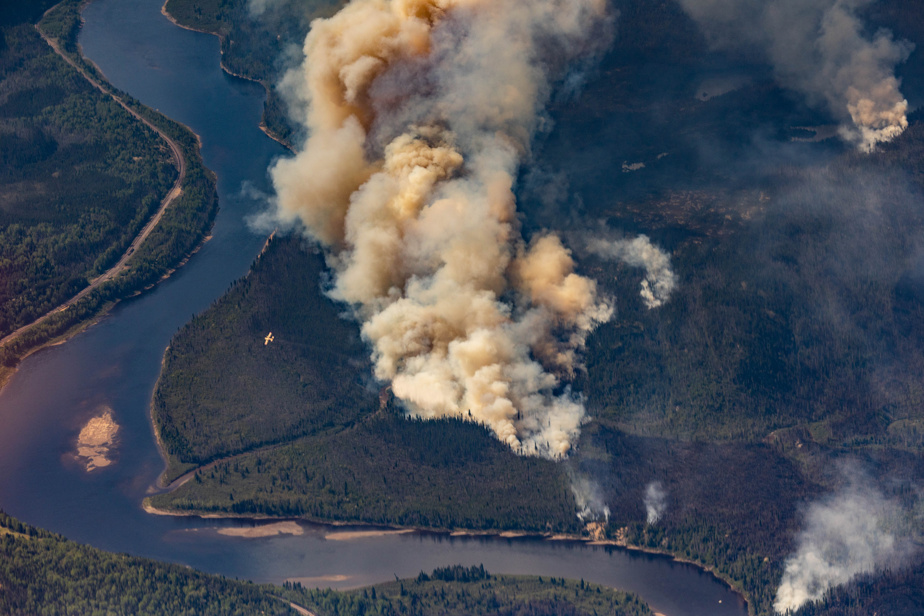Forest fires must be taken into account in planning forest harvesting, forest experts argue in a harsh critique of the current approach, which is an afterthought.
“The Chief Forester cannot claim to have determined sustainable cutting levels”, write in an open letter1 published this Thursday in The Press Yves Bergeron, professor at the University of Quebec in Abitibi-Témiscamingue (UQAT) and at the University of Quebec in Montreal (UQAM) specializing in ecology and forest management, Alain Leduc, professor in the department of biological sciences at UQAM, and Jean-Pierre Jetté, forest engineer.
The Chief Forester of Quebec predicts the potential impact of fire on the availability of harvestable wood only in two forest management units in Nord-du-Québec, out of the 57 in the province; he sets up a “precautionary reserve” of up to 20% of the volume of wood available to take into account the more frequent fires in these places.
Elsewhere, it takes into account the risk of fire ” a posteriori », by recalculating the volume available after the passage of the fire.
What is a precautionary reserve?
A precautionary reserve is a volume of timber that is subtracted from allowable cuts. If the fire destroys part of the remaining forest possibilities, the precautionary reserve is used, so that the volume initially planned remains the same. Forest companies therefore do not experience any unforeseen changes in the volume of timber guaranteed to them by the State.
This way of doing things exposes forest regions to “greater vulnerability”, since the readjustment is necessarily downward, which can lead to job losses and sudden financial losses, write the authors of the letter.
Rather, the approach adopted in Nord-du-Québec should be applied across Quebec, especially since the boreal forest will burn more often due to climate change, they argue.
Such a readjustment would imply a reduction in the volume of timber granted to the industry, but this reduction would have the advantage of being predictable, argue the authors.
“This drop can be done in an organized way or it will happen in a brutal and unpredictable way, depending on future fires,” they say.
Other solutions
Chief forester Louis Pelletier defends his approach by saying that it is possible to “reduce the risk associated with natural disturbances” by applying mitigation measures, he explained during an interview with The Press.
The state can plant species that have better fire resistance, such as jack pine, rather than black spruce, or maintain a greater proportion of hardwoods, which burn less quickly and less well than softwoods, illustrates Mr. Peltier.
The authors of the letter, however, are unconvinced.
“Intensifying forestry to compensate for future losses means investing more and more in forests that will burn,” says Jean-Pierre Jetté.
We are caught in a gear where, to support greedy industrial production, the State is obliged to invest without guarantee that it will work.
Jean-Pierre Jetté, forest engineer
Louis Pelletier does not rule out extending preventive management of the impact of forest fires to other regions, but says he wants to first “run tests to see what the effect is” of the measures envisaged.
Because establishing precautionary reserves is the equivalent of paying a large insurance premium so as not to have a deductible to pay in the event of a disaster, illustrates Jean Girard, director of calculations and analyzes at the Office of the Chief Forester.

PHOTO DAVID BOILY, THE PRESS
The Chief Forester of Quebec predicts the potential impact of fires on the availability of harvestable timber in a minority of forest management units in the province.
In the meantime, if it is necessary to reduce the allowable cuts to take into account the current forest fires, Louis Pelletier will do so, “and there will be consequences”, he warns, recalling that his role is first of all to ensure the sustainability of the forest by preventing it from being overexploited.
Neutrality
The situation illustrates once again the need for Quebec to have an independent observatory on the forest, says Yves Bergeron, signatory of the letter, who believes that the role of the Chief Forester is above all to ensure the supply factories.
“He may be a good person, but I think he’s not neutral,” he said.
The Order of Forest Engineers of Quebec is also of the opinion that there should be “more transparency” in the calculation of allowable cuts, says its president, François Laliberté, who also says he is in favor of taking forest fires into account. forest upstream.
In particular, the College proposes the creation of a “designated forest manager” position, which could establish its own objectives and the means of achieving them, noting that the concept exists in Ontario and elsewhere in the world.
The Quebec Forest Industry Council did not call back The Press.
Learn more
-
- 34,916,800m3
- Allowable cuts (volume of timber offered to industry) for all of Quebec for the period 2023-2028
Source: Office of the Chief Forester of Quebec
- 253,800m3
- Allowable cuts for the two Nord-du-Québec management units where a precautionary reserve has been planned to take forest fires into account for the 2023-2028 period
Source: Office of the Chief Forester of Quebec
